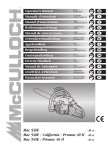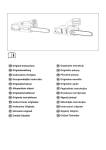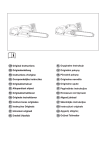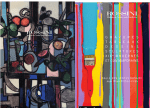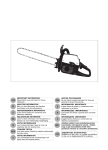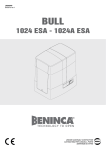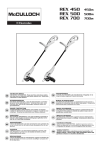Download AEG Electrolux PROMAC 40 II 40 CC Operator`s manual
Transcript
MAC 538E / MAC 539E 38 CC MAC 540E / PROMAC 40 II 40 CC MAC 542E / CALIFORNIA 42 CC MAC 545E / PROMAC 46 II 46 CC P 538E / EUROMAC S42 / S44 38 CC P 540E 40 CC P 542E / EUROMAC S43 42 CC P 461 II / TITANIUM 460 46 CC Electrolux Outdoor Products Via Como 72 23868 Valmadrera (Lecco) ITALIA Phone + 39 0341 203111 - Fax +39 0341 581671 Our policy of continuous improvement means that the specification of products may be altered from time to time without prior notice. Electrolux Outdoor Products manufacture products for a number of well known brands under various registered patents, designs and trademarks in several countries. © Electrolux Outdoor Products The Electrolux Group. The world’s No.1 choice. The Electrolux Group is the world’s largest producer of powered appliances for kitchen, cleaning and outdoor use. More than 55 million Electrolux Group products (such as refrigerators, cookers, washing machines, vacuum cleaners, chain saws and lawn mowers) are sold each year to a value of approx. USD 14 billion in more than 150 countries around the world. PN. 249453 REV. 00 (04/04) A. C. B. D. E. H. MAC 540E - MAC 542E MAC 538E - MAC 539E California - MAC 545E P 540E - P 542E P 538E - Euromac S42 Euromac S43 Euromac S44 Titanium 460 14” 50T 350mm 3/8” GB Promac 40 II Promac 46 II P 461 II F. I. 400mm 55T 3/8” 18” 450mm 60T 3/8” 16” 400mm 66T .325” FR NL NO X FI SE (5/32”) 16” DE DK X X (5/32”) (5/32”) X X (5/32”) (5/32”) ES PT IT GR HU CZ X PL TR (3/16”) RU 18” 450mm 72T .325” X (3/16”) G. L. Due to a constant product improvement programme, the factory reserves the right to modify technical details mentioned in this manual without prior notice. Im Sinne des Fortschritts behält sich der Hersteller das Recht vor, technische Änderungen ohne vorherigen Hinweis durchzuführen. La Maison se réserve la possibilité de changer des caractéristiques et des données de ce manuel à n’importe quel moment et sans préavis. Door konstante produkt ontwikkeling behoud de fabrikant zich het recht voor om rechnische specificaties zoals vermeld in deze handleiding te veranderen zonder biervan vooraf bericht te geven. Produsenten forbeholder seg all rett og mulighet til å forandre tekniske detaljer i denne manualen uten forhåndsvarsel. Jatkuvan tuotteen parannusohjelman tähden valmistaja pidättää oikeuden vaihtaa ilman ennakkovaroitusta tässä ohjekirjasessa mainittuja teknisiä yksityiskohtia. Tilverkaren reserverar sig rätten att ändra fakta och uppgifter ur handboken utan förvarning. Producenten forbeholder sig ret til ændringer, hvad angår karakteristika og data i nærværende instruktion, når som helst og uden varsel. La firma productora se reserva la posibilidad de cambiar las características y datos del presente manual en cualquier momento y sin previo aviso. A casa productora se reserva a possibilidade de variar características e dados do presente manual em qualquer momento e sen aviso prévio. La casa produttrice si riserva la possibilità di variare caratteristiche e dati del presente manuale in qualunque momento e senza preavviso. Λγω προγράµµατος συνεχούς βελτίωσης προϊντων, το εργοστάσιο επιφυλάσσεται του δικαιώµατος να τροποποιεί τις τεχνικές λεπτοµέρειες που αναφέρονται στο εγχειρίδιο αυτ χωρίς προηγούµενη ειδοποίηση. Folyamatos gyártmány felùjítási müsorunk következtében, a gyártó cég fenntartja a jogát ebben a Használati leirt müszaki adatok elözetes értesítés nélküli változtatására. Výrobce si ve smyslu pokroku ponechává právo na provedení technických změn bez jejich předchozího oznámení. W związku z programem ustawicznego ulepszania swoich wyrobów producent zastrzega sobie prawo do wprowadzania zmian w szczegółach technicznych wymienionych w tej instrukcji bez uprzedniego zawiadomienia. Üretici firma, istedi¤i anda ve önceden haber vermesine gerek olmadan bu kullanma talimatındaki karakteristikleri ve teknik özellikleri de¤ifltirme hakkını saklı tutar. A. General description 1 - BAR 2 - CHAIN 3 - FUEL TANK CAP 4 - OIL TANK CAP 5 - STOP SWITCH 6 - STARTER HOUSING 7 - STARTER HANDLE 8 - FRONT HANDLE 9 - AIR FILTER COVER 10 - CHOKE KNOB 11 - CARBURETOR ADJUSTMENT SCREWS 12 - SAFETY CHAIN BRAKE 13 14 15 16 17 18 19 20 21 22 23 - BAR RETAINING NUTS - CHAIN CATCHER - MUFFLER SHIELD - REAR HANDLE - THROTTLE TRIGGER LOCKOUT - THROTTLE TRIGGER - CHAIN BRAKE COVER - CHAIN ADJUSTER SCREW / INTENZ - SPIKE/SPACER - THROTTLE ADVANCE - DECOMPRESSION VALVE Safety precautions If not used properly this chainsaw can be dangerous. The warnings and safety instructions must be followed to ensure reasonable safety and efficiency in using this product. The operator is responsible for following the warnings and instructions in this manual and on the product. Explanation of Symbols Always have a first aid kit nearby Read operator’s manual carefully Wear safety clothing: Approved safety glasses or face shield Noise emission to the environment according to the European Community’s Directive. Approved safety helmet This product is in accordance with applicable EC directives. Approved ear defender Do not smoke while refuelling or while operating the machine Approved gloves Approved safety footwear Warning - Caution Choke fully opened (hot start /run) ENGLISH - 1 Choke partially opened Do not cut with the end on the bar, this may cause kickback Choke closed (cold start) Never use the machine with only one hand Stopping Always use the machine with both hands Brake engaged / disengaged Switch off the engine by moving the stop switch to the STOP position before carrying out any checks or maintenance. Beware of kickback Oil/petrol mix B. Safety precautions 1 All operators should read this manual carefully before using this chainsaw; only use this machine for usage specifically mentioned in this manual. Wear suitable clothing. This should include snugly-fitting (safety) clothing, sturdy boots, heavy duty gloves, goggles or a face screen and ear plugs or ear mufflers. Wear a helmet if there is risk of falling objects or projections from trees. 2 Always hold the chainsaw firmly with both hands when the engine is running. Always maintain a firm foothold. Ensure you are able to stop the engine quickly if necessary.Do not work up a tree unless you have received suitable training and have the appropriate equipment (belts, ropes, safety hooks etc.) for this type of work. We strongly recommend that all first-time chainsaw users obtain practical instruction on safe chainsaw usage before operating the chainsaw. Do not operate this machine when tired or under the influence of any substances, drugs or alcohol which can impair vision, dexterity or judgement. Prolonged use of chainsaws or other machines exposing the operator to vibration may produce Whitefinger’s Disease (Raynaud’s Phenomenon). This may reduce the hands’ ability to feel and regulate temperature and may produce general numbness. Continual or regular users should therefore monitor closely the condition of their ENGLISH - 2 hands or fingers. If any of the symptoms appear, seek immediate medical advice. 3 Never carry the chainsaw with the engine running. Whenever carrying a chainsaw, even for short distances, the chain should be covered by the chain guard (scabbard) and the bar should point backwards. When transporting the chainsaw in a vehicle, secure the saw to prevent fuel spillage. 4 To avoid kick-back, do not attempt to cut with the nose of the bar. Ensure the engine is running at full throttle before commencing to cut. To avoid kick-back, do not let the nose of the bar come into contact with logs, branches, the ground or any other obstruction. Do not allow any part of the chain to come into contact with rock, nails or wire fence Ensure the chain is kept sharp and correctly tensioned. Keep the spike or the saw body against the wood when cutting. Use only genuine accessories and spare parts. We recommend you have your unit periodically checked and serviced by an authorised dealer. Do not use chainsaw above shoulder height. 5 Do not operate the chainsaw near a naked flame or spilled fuel. Only operate the chainsaw outside and in well ventilated areas. After re-fuelling, always wipe off any spilled fuel. Move the chainsaw away from the fuelling point before starting the engine. 6 Keep by-standers and animals out of the work area; at a minimum distance of 10 m or twice the timber length. If necessary, use warning signs to keep on-lookers at a distance. Carefully survey the working site to note any hazards, eg. roads, paths, electricity cables, dangerous trees etc. Do not use the chainsaw if the device for stopping the chain (safety chainbrake) does not work correctly. Never place hands on the chain whilst the engine is running. Ensure someone is within hearing distance in case of an accident. If this is not possible, it is recommended that users operating chainsaws in remote areas carry an adequate first-aid kit with them and ensure someone knows their location. Never leave the engine running while the tool is unattended. NEVER USE A CHAIN SAW THAT HAS FAULTY SAFETY EQUIPMENT! Carry out the inspection, maintenance and service routines listed in this section. ONLY USE ORIGINAL SPARE PARTS AND ACCESSORIES. C. Bar and chain installation - Intenz Ensure engine is always switched off before fitting or adjusting chain. Wear a pair of protective gloves when fitting or adjusting chain. 1 Ensure chain brake lever is in disengaged position (A). Remove retaining nuts (B) and cover. 2 Turn the adjusting screw (D) counterclockwise taking it fully back. 3 Feed chain into bar groove ensuring correct direction of chain (P). 4 Work the chain around sprocket and set the bar as illustrated, make the lower hole (F) coincide with the pin (G) of the adjusting screw. 5 Reposition side cover. Fit spike as illustrated. 6 Lock nuts (B) finger tight. Adjust chain tension pin by turning screw (D) so that when lifting the chain an entire drive link is just visible. The chain is correctly tensioned when there is no slack on the underside of the bar, and it runs freely in bar groove. Tighten the bar retaining nuts with the wrench, pushing bar tip upwards. INTENZ Turn the adjusting screw (I) counterclockwise taking it fully back. Feed chain into bar groove ensuring correct direction of chain (P). Lock nuts (B) finger tight. Adjust chain tension pin by turning screw (I) so that when lifting the chain an entire drive link is just visible. The chain is correctly tensioned when there is no slack on the underside of the bar, and it runs freely in bar groove. Tighten the bar retaining nuts with the wrench, pushing bar tip upwards. D. Fuel mix Do not use any other type of fuel than the type recommended in this manual. This product is equipped with a two-stroke engine and must therefore use a mixture of lead-free gasoline (with a minimum of 90 octanes) and fully synthetic oil for two-stroke engines, specific for lead-free gasoline in the proportions indicated in the table on the cover page at item (D). IMPORTANT! Read the oil specifications on the can carefully: the use of oil lacking the specifications indicated in this manual can cause severe damage to the engine! To obtain the best mixture, pour the oil first, followed by the gasoline, into an approved container, shake well (repeat the operation every time you draw any fuel from the container). The characteristics of the mixture are subject to aging and may be altered in time, so we recommend mixing only the amount strictly needed for use. If you use a mixture that is several weeks old, this could damage the engine. WARNING Do not smoke when re-fuelling. Always open the fuel cap slowly. Re-fuel in open spaces only, keeping away from naked flames or sparks. Always store fuel in an approved container. SAFE STORAGE OF FUEL Petrol is highly inflammable. Put out all cigarettes, pipes and cigars before working with petrol. Avoid spilling petrol. Store fuel in a cool, well ventilated place, in an approved container specifically designed for the purpose. Never store engine with fuel in the tank in enclosed, poorly ventilated areas, where fuel fumes may reach an open flame, spark or pilot light such as in a furnace, water heater, clothes dryer etc. Petrol fumes can cause an explosion or a fire. Do not store large amounts of fuel. CHAIN LUBRICATION IMPORTANT The service life of the bar and chain depends on good lubrication. Always use chain lubricating oil of medium viscosity. We recommend special McCulloch chain lubricating oil. Never use waste oil for this purpose. This results in damage to the bar, the chain and the oil pump. Refill the chain oil tank each time the saw is refuelled. To prevent possible restarting problems avoid running the fuel tank dry. This also helps to extend engine life. NOTE: Saw chain stretches during use particularly when it is new, and it will occasionally be necessary to adjust and tighten it. A new chain will require adjustment after about 5 minutes of operation. The mechanical oil pump for chain lubrication can be adjusted. The feed rate of the chain oil pump can be adjusted by means of the regulating screw (A) (see details in the illustration). ENGLISH - 3 E. Starting and stopping IMPORTANT Never start or operate unless bar and chain are properly installed. Before starting always move the saw away from the fuelling area and place it on a firm, flat surface, the guide bar to the front. STARTING A COLD ENGINE 1 Check that the chain brake is in the disengaged position moving the lever (L) towards the front handle. Move the stop switch upwards . 2 Slide the choke lever (A) to the CLOSED position (OUT). Push the decompression valve (D) down if your models is fitted with one. 3 Depress throttle trigger lock out (S). Depress throttle trigger (G) and then operate throttle advance (P) moving it backwards. 4 Hold the saw firmly as shown in illustration and pull the starter rope until the engine fires once. Beware of moving chain! 5 Move choke lever (A) to the OPEN position (IN). Push the decompression valve (D) down if your models is fitted with one. Pull the starter rope until the engine starts. Allow engine to warm up for ten seconds for better cutting performance. Squeeze the throttle trigger (G) to release the throttle advance. If engine fails to start, repeat these instructions. 6 The engine is stopped by depressing the STOP switch to STOP position. After lengthy use of the chain at full speed,we recommend to run the engine for a few seconds at idle speed before stopping it. STARTING A WARM ENGINE Check that the ignition switch is not in the “stop” position and do not use the throttle lock. Hold the saw firmly, press valve (D) for decompression and pull the starter rope. STARTING A WARM ENGINE AFTER RE-FUELLING In the fuel tank as run completely dry, procede to start as with a cold engine. F. Usage IMPORTANT Before using a chain saw read the Operator’s Manual and all safety precautions carefully. FELLING TREES – Make sure that there are no bystanders or animals in the work area. – Study the direction of the fall of the tree and then plan your exit path away from the planned direction of fall. – Don’t fell trees when there is a strong wind. 1 Clear the tree base of interfering limbs and brush. Clean the work area from stones or other objects which could damage the chain. If the tree has large protruding roots, remove them before felling (see illustrations). 2 A) Cut a felling notch (A) of 45°on the side you want the tree to fall to a depth of about one third of the trunk diameter (d). Then make a felling cut (B) about 5 cm higher than the felling notch on the opposite side of the tree. Make sure that the felling cut does not go right through the trunk. A hinge (C) must always be left to provide control over the direction of the fall. B) Use wedges to control the moment and direction of the fall. 3 When the tree starts to fall, walk away along your preplanned escape path. CUTTING FALLEN TRUNKS 4 A) Limbing thick branches. For limbing and bucking leave the lower limbs to support the log off the ground. B) Supported at one end only. Begin with a bottom cut made by the upper side of the bar (A); the depth of the cut should be about one third of the log diameter. Finnish with a top cut (B) meeting the first one. With this technique splitting, cracking can be avoided C) Supported at both ends. Begin with a top cut about one third of the log diameter. Then finish with a bottom cut (B) meeting the first one. this technique avoids the risk of pinching the bar in the log. D) If the log is supported along its whole length it may be cut normally from above. Take care not to touch the ground with the chain. • When working on a slope always stand on the uphill. • When cutting prepared timber, use clamps or chocks to secure work. • Use extreme caution when cutting small size brush and saplings which may catch the chain and pull you off balance. G. Carburettor adjustment We suggest carburetor adjustments are made by an authorized servicing dealer. The carburetor has three adjustment screws: ENGLISH - 4 • L: The needle screw L governs the fuel flow at low speed and also the acceleration from low to full speed. To set screw L: close screw L turning it clockwise without forcing. Then open screw 1 full turn (counterclockwise) . If acceleration is not smooth, open another 1/8 turn to increase fuel flow . • H: The needle screw H governs fuel flow at high speed (throttle valve fully open). To set hi speed screw H: close screw H turning it clockwise without forcing . Then open screw 1 full turn (counterclockwise) . If the engine speed is too high, open the screw about 1/8 turn (counterclockwise). Optimal adjustment is found between 1 and 1 1/4 turns. • I: The I (IDLE) screw controls the throttle opening to govern idle speed (2800 min-1) adjust as necessary. CAUTION: increased idle speed may cause chain movement. The carburetor is adjusted for normal operation during production. When considerable changes of altitude require a supplementary adjustment, contact an authorised service station which offers the latest in tools, parts and technical assistance. H. Routine maintenance Ensure engine is always switched off before any kind of maintenance operation. CHAIN: Check tension regularly. A new chain will require more frequent adjustment. Loosen retention nuts. Tighten chain (see assembly instructions). Tighten retention nuts and adjust. 1 BAR – Clean the bar groove (K) and check the lubrication holes (L) in the bar to ensure that they are not clogged. – Grease sprocket periodically. Rotate sprocket and repeat. – Rotate bar periodically to maximise bar life. 2 AIR FILTER – A dust clogged air filter may cause carburetor problems. This may prevent the engine from reaching its maximum r.p.m. and cause high fuel consumption. – Remove cover. – Wash filter in petrol (do not use fuel which is mixed with oil). – The filter can also be cleaned with compressed air. – Replace filter if damaged or if it does not seal tightly in the air box. 3 SPARK PLUG Remove and clean the spark plug every 30 hours. Check the electrode gap (0,5/0,6 mm. - 0.025 inches). – Replace spark plug about every 100 working hours or whenever it is extremely encrusted. – Heavily encrusted electrodes can result from an incorrect carburetor setting or from wrong fuel mixture (too much oil in the fuel mix) or a poor quality of oil in the fuel mix. Check and correct. 4 OIL FILTER The oil filter is on the end of the oil suction hose inside the oil tank. To clean and replace the filter pull it out through the oil tank filter opening. Use a piece of bent wire or long forceps. To remove deposits from the oil tank half-fill it with kerosene or petrol and shake thoroughly. Drain off and fill the tank with fresh saw chain oil. Never use waste oil. 5 FUEL FILTER To change fuel filter remove the tank cap and pull out the filter with a piece of bent wire or long forceps. Replace the filter as shown in the illustration and reposition it. It is recommended to replace the fuel filter at least once a year. CHAIN BRAKE – WARNING: Contact your service dealer if anything appears wrong with your chain brake. Do not disassemble or manipulate the mechanism of the chain brake. – Clean the brake mechanism periodically (without disassembling it) and control the wear of the band visually. • PERIODICALLY: It is important to clean the saw thoroughly particularly around cylinder fins to avoid overheating of the engine. • LONG STORAGE: Empty fuel and run engine until dry. I. Safety chain brake Your chain saw is fitted with a safety chainbrake designed to stop the chain in milliseconds in case of kickback. Always hold the saw firmly in both hands. The chain brake does not provide a total protection if the machine is used without taking the necessary precautions and maintenances. The chain brake is intended to engage automatically in case of kickback. The chain brake can also be engaged manually by pushing the chain brake lever forwards.The manual use of the chain brake is recommended only at idle. Always test the chain brake before using your saw. Do this by engaging the brake at idle (see below). Always release the brake before starting. Kickback may occur if the end of the bar (see illustrated angle) touches any solid object. Never attempt to start a cut with the end of the bar. Kickback is a violent upward and rearward movement of the bar and may cause you to lose control of the machine. Therefore you should avoid starting a cut with this part of the bar. Always keep a firm grip on the saw with both hands because, in case of kickback, it is the contact of the left hand with the brake lever which will help to engage the brake. CHAIN BRAKE TESTING: 1 The chain brake (A) is disengaged when brake lever is pulled back and locked(chain can move). 2 The chain brake (A) is engaged when brake lever is in the position (chain cannot rotate). ENGLISH - 5 The chain brake should snap into both positions.If strong resistance is felt or lever does not move into either position, DO NOT USE YOUR SAW. Take it immediately to an authorized servicing dealer. 3 CHAIN CATCHER This unit is fitted with a chain catcher below the drive spocket. This is intended to stop the rearward movement of the chain in case of breakage or if it should come out of the bar. It should never be removed. L. Chain sharpening 1 Chain cutter teeth can be sharpened with a round file, as follows: CHAIN FILE MP 370 GLX 5/32” PM 320 GX 3/16” The exact chain type is marked on the bottom half of the drive link which runs inside the bar groove. Filing can be made easier by also using a file holder. The chain can remain fitted on the bar during sharpening. Before commencing, the chain should be tensioned correctly and the chain brake should be activated to prevent the chain from moving. 2 To obtain a correct sharpening the file must be carefully held to maintain 3 basic angles: – “A” Top angle 30° - 35° – “B” External, side angle 85° - 90° – “C” Internal, side angle 60° File in one direction only, from the “inside” of the cutter tooth towards the “outside”. Do not allow the file to touch the chain as you bring it back to re-position it. Each cutter tooth should be filed with the same number of strokes. 3 The file should be held horizontally to the cutter tooth being sharpened. 4 Best results to obtain a precise sideways angle can be obtained by holding the file so that it rises 0,5 mm above the top face of the cutter tooth. 5 DEPTH GAUGE Correct depth gauge height is vital to ensure maximum chain life and cutting efficiency. The height of the depth gauge should be lowered as the cutter tooth is filed back; this height should be checked every 4 or 5 sharpenings. The best way to do this is to use a flat file and a depth gauge tool. The correct setting is 0.65 mm below the top edge of the cutter tooth. The cutter tooth depth gauge should then be rounded (D). Specification THIS PRODUCT MEETS THE SAFETY STANDARD REQUIREMENT OF THE EUROPEAN MACHINERY DIRECTIVE DISPLACEMENT (cm3) BORE AND STROKE (mm) ENGINE OUTPUT (kW) (ISO 7293) ENGINE SPEED AT MAX POWER (min-1) MAXIMUM SPEED (min-1) MINIMUM SPEED (min-1) DRY WEIGHT (Kg) (NO BAR AND CHAIN) CHAIN PITCH (9,525 - 8,255 mm) CHAIN GAUGE (mm) BAR LENGTHS (cm) No. OF SPROCKET TEETH OIL TANK CAPACITY (cm3) FUEL TANK CAPACITY (cm3) SOUND PRESSURE LEVEL (AT THE OPERATOR’S EAR). LpAav (dBA) (EN 27182 - EN 608) GUARANTEED SOUND POWER LEVEL LwAav (dBA) (ISO 9207 - EN 608) MEASURED SOUND POWER LEVEL LwAav (dBA) (ISO 9207 - EN 608) VIBRATION LEVEL (ISO 7505 - EN 608) (m/s2) 38 40x30 1,5 8.500 11.000 2.800 5 3/8” 1,3 35/40/45 6 290 390 97 112 111 7,5 40 41x30 1,75 8.500 11.000 2.800 5 .325” 1,3 40/45 7 290 390 97 112 111 8,7 42 46 41x32 43x32 2 2,4 9.000 9.000 12.000 11.000 2.800 2.800 5,5 5,5 3/8”-.325” 3/8”-.325” 1,3 1,3 40/45 40/45 6/7 6/7 290 290 390 390 98 98 112 113 111 112 6,9 6,9 EC Declaration of Conformity The undersigned, authorised by E.O.P.I., declares that the petrol-driven chainsaw MS 38E, MS 40E, MS 42E, MS 46E, manufactured by E.O.P.I., 23868 Valmadrera (LC), Via Como 72, Italy, is in accordance with the European Directives 98/37/CEE (Machinery Directive), 73/23/EEC (Low Voltage Directive), 93/68/CEE (CE Marking Directive) & 89/336/CEE (Directive on electromagnetic compatibility). Directive 2000/14/ECC (Annex V). Valmadrera, 15.12.01 Pino Todero (Direttore Tecnico) E.O.P.I. ENGLISH - 6 Fault finding table Engine will not start Check STOP switch is in the position I. Control fuel level min. 25% tank capacity. Engine runs badly Engine runs badly or looses power when cutting • Check air filter is clean. • • • • Remove spark plug, dry it, clean it and adjust it, and replace it, if necessary. • • Control and adjust the carburetor screws if necessary. The chainsaw runs but does not cut well • • Change fuel filter. Contact your dealer. • Carefully follow the chain assembly instructions. • Check chain is sharp. Otherwise, contact your dealer. • Engine still gives trouble: contact your dealer. ENGLISH - 7









